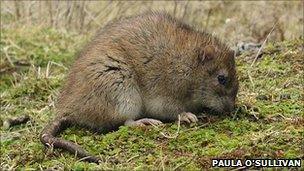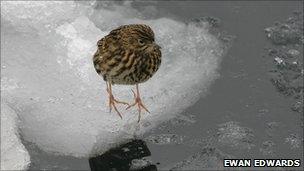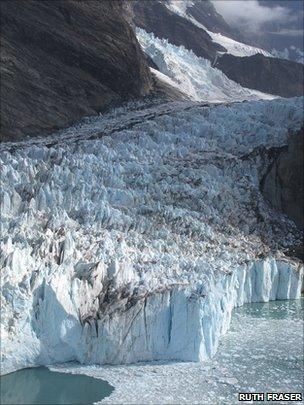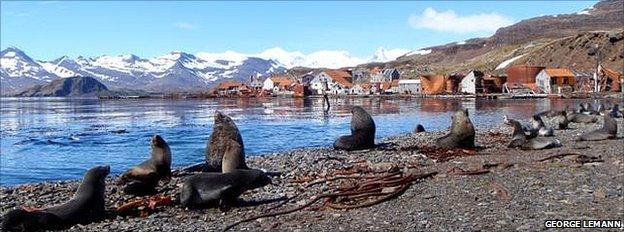'Success' in South Georgia rat eradication
- Published

The brown rat has been a catastrophic introduction to South Georgia
Conservationists say they are pleased with early efforts to kill rats on South Georgia, in what is the biggest rodent eradication campaign in history.
No-one really knows how many rats inhabit the island in the South Atlantic, but it could be millions.
Introduced on the ships of sealers and whalers in the 19th and 20th Centuries, the rodents have had a devastating impact on local seabird populations.
But the laying of toxic bait in part of the island seems to have had success.
Some 50 tonnes of rodenticide were spread by helicopters in March over a contained zone hemmed in by glaciers. Subsequent inspections on the ground found only dead rats.
The kill represented just the first phase in the project, and covered a mere 13% of the rat-infested land area of South Georgia.

The helicopters flew back and forth along GPS grid lines to distribute the bait
Nonetheless, the South Georgia Heritage Trust says it has been hugely encouraged by the results.
"Prior to the baiting, if you went out at night, there were rats running everywhere," explained project leader Professor Tony Martin from Dundee University, UK.
"A week after the bait went down - not a sign of a single rat. We even put out little batches of bait pellets that were particularly attractive to the rats. We saw them being taken for the first few days, and then there were no more pellets taken."
First surveyed by the great explorer James Cook in 1775, the UK overseas territory is rightly famed for its wildlife.
Thousands of tourists visit the 170km long island to see its seals, penguins, albatrosses and other birds.

The pipit is Earth's southern-most songbird
But as abundant as these animals appear, their populations are as nothing compared to the days before industrial sealers and whalers used the British protectorate as a base for their ships and processing plants.
Although these industries have long gone, their legacy remains in the form of the brown rat which leapt on to shore and ran riot across the island.
The rodents kill the fat chicks of ground-nesting seabirds. They eat them alive - albatrosses, petrels, prions; anything the rats can get their teeth into, and that includes chicks that may be several times their size.
Particular concern surrounds the South Georgia Pipit (Anthus antarcticus), the most southerly songbird on the planet; and the South Georgia Pintail (Anas georgica georgica), a duck species found only on South Georgia.
"These simply will not nest in the presence of rats," said Dr Mike Richardson who chairs the steering committee of the South Georgia Heritage Trust Habitat Restoration Project.
"Rats have driven them into small refuges, which tend to be the small offshore islands around South Georgia's coast. But on the mainland, all along its north coast, South Georgia has become a no-go area for these birds."
Rat eradication has been tried on other islands around the world, notably off New Zealand and Australia - but nothing on the scale being attempted in South Georgia.
Ordinarily, such a campaign would probably be impossible, such is the size of the landmass and the number of rats present. But the sub-Antarctic island is marked by numerous glaciers that divide up the territory into convenient killing zones that can be cleared one by one. The rats cannot cross the ice tongues and so conservationists can be sure rodents from neighbouring zones will not re-infest baited areas at a later date.
The March baiting campaign used two helicopters to cover 150-sq-km of ground centred on Thatcher Peninsula. The bait pellets, donated by Bell Laboratories in the US, were spread from large hoppers slung beneath the aircraft. The helicopters flew back and forth along GPS grid lines, ensuring every hectare was littered with about 2kg of rodenticide.

The glaciers act as barriers to the rats
This first phase cost about £1.6m, and the South Georgia Heritage Trust calculates the project will require a further £5m and two campaign seasons to completely remove the rodents from the island.
Inevitably, there is collateral damage in the form of birds and other wildlife also consuming the bait. But the shape, colour and size of pellets have been carefully designed to minimise accidental deaths.
And Professor Martin says these small losses have to be set against the benefits to nesting populations that will accrue in the years ahead.
"When Captain Cook first set foot on the island in 1775 this was perhaps the most important seabird breeding island in the world," he told BBC News.
"By far the majority of the birds have been removed by one agent - rats - which man introduced. What we're doing is turning back the clock two centuries to try to get the island back to where it was; and it's something we do believe can be accomplished."

South Georgia was even richer in wildlife before the whaling settlements (far view)
- Published15 December 2010